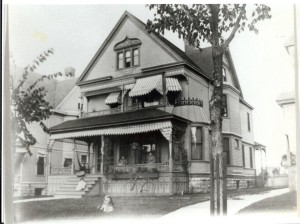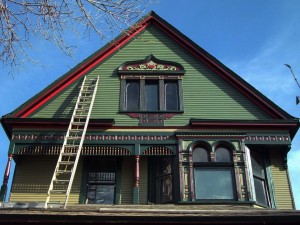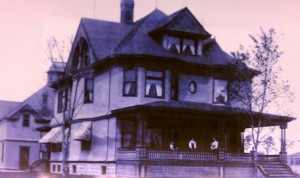Because of a family emergency, we regret that we have had to cancel this tour. Thanks for your interest. Watch the blog for other upcoming Healy Project events.

Front dormer of the George F. Bates House on Second Ave., 1886.
On Sunday, November 8th, at 1 p.m. the Healy Project is offering their second tour of the Healy Block Historic District and environs, giving tour-goers a glimpse into the creation of these historic houses and ongoing efforts to preserve them. On the National Register of Historic Places, the Healy Block is the finest group of Queen Anne houses in Minnesota. They are located on the 3100 block of Second and Third Avenues, right off the 31st Street exit on northbound I-35W.

Windows in a house on the Healy Block

Balcony under the front dormer of 3101 Second Ave. S., the Dr. Rufus F. Lane House.
Sign in for the tour beginning at 12:30 at the George F. Bates House, 3139 Second Ave. S. (built by Healy in 1886). You’ll be able to see the interior of two houses and a beautiful Healy barn conversion.
A couple of decades ago, many houses on the Block came close to being demolished. Find out how over the years a dedicated group of residents have made the Healy Block into a Minnesota landmark.

The J.B. Hudson House when it was new (1890s).

The J.B.Hudson House with the asbestos siding being removed. 1978.

The facade of the Hudson House getting repainted (2012).–photo by Madeline Douglass
–T.B.

The Healy Block before I-35W took out the houses on the west (right) side.
Great news for Healy’s most famous Queen Anne houses: On Monday evening, March 23rd, at a meeting held by Hennepin County and the City of Minneapolis with residents of the Healy Block Historic District, the proposed sound wall was defeated by unanimous vote among those residents present. In addition, a new proposed design for the I-35W expansion was presented and approved. Monday’s win for the Block is an inspiration for the preservation community: an example of how historic district residents can triumph during a long and challenging political process.
Plans for expanding and redesigning I-35W at the 31st Street exit have been in the works for a long time. Since the early 1990s, various plans have come and gone, representing serious threats to the Healy Block. In their current manifestation, expansion plans were introduced more than four years ago. Negotiation and discussion between the various government entities (federal, state, county and local) and the Block residents have been going on since then. (See post Threats to Healy Houses Renewed) Over a year ago Block representatives met with MNDOT commissioner Charles Zelle to work out some of the issues with the design. The new design and the nixing of the sound wall represent a significant win for livability of the residents on the Block and the future preservation of these historic houses.

Dormer of 3100 Second Ave. South, on the Healy Block.
David Piehl, who owns and lives in the J.B Hudson House on the Block, explains why eliminating the sound wall from the expansion plans is important: “A wall would be ugly, and the snow storage requirements for the freeway would mean the wall would be 10 feet closer to our homes than it currently is, in addition to being 20 feet high on top of the already-high embankment. Furthermore, the improvement in noise levels was projected to be around 5 decibels, which is not nearly significant enough for us to want to make the other sacrifices the wall would require.”
After the vote on the sound wall, discussion turned to the design of the off-ramp. Residents previously selected a design with a single-lane ramp, separated from Second Avenue by a median. However, the Federal Highway Administration vetoed it as “fatally flawed” due to lack of “storage.” That left another option which was very similar, but had a two-lane ramp.
At the meeting Block residents David Piehl, Ioannis Nompelis, and Pete Holly fought hard to keep the pavement and traffic as far from the historic houses as feasible. Residents recognize that Second Avenue on the 3000-3100 blocks serves three purposes–as a residential street, an off-ramp, and frontage road.

The Healy-Rea House, 3131 Second Ave. S. on the Healy Block, Healy’s second home in Minneapolis.
On Monday project organizers presented a modified design that has the ramp starting as single lane, then widening to two. They also widened the median separating Second Avenue from the ramp to 12 feet by taking a portion of the embankment. As Piehl reports, Block residents “are OK with this because it moves green space closer to our homes and the ramp further away. We wanted the median to be wide enough to be planted, so we can plant a visual screen between Second and the ramp, and we got that. A visual screen will also be re-planted on the embankment. The proposed median runs all the way to 31st Street. Second Avenue becomes a single lane with parking, but entirely separate from the ramp south of 31st. Even better, Second at 31st will be ‘right turn only’ due to adding 20 feet of boulevard space in front of the two homes on the 3000 block—which again moves traffic away from those homes, improving livability. The ‘right turn only’ lane reduces the appeal of 2nd Ave as a ‘frontage road’. The upshot is that Second Avenue will be a single lane residential street separated from the ramp by a 12-foot-wide, planted median.”

Porch detail, 3111 Second Ave. S., the Broom House.
The miracle is that after four years of negotiating and fighting with the various entities involved in the I-35W expansion, residents of the Healy Block finally got nearly everything they asked for, short of moving the ramp. As Piehl says, “It is amazing to think that they started with bringing the freeway 30 feet closer, and a massive retaining wall–and we got them to a place where the plan is an improvement over what currently exists!”
This is a truly remarkable win for preservation in Minneapolis. Thanks go to a talented city planner, Jeni Hager, who diligently designed, re-designed, and re-designed again to ensure that the current proposal satisfied residents’ aesthetic and livability concerns as well as state and federal requirements. Many thanks also to supportive City Council members Elizabeth Glidden and Alondra Cano for their leadership. And finally, thanks and congratulations to David Piehl, Ioannis Nompelis, Pete Holly, John Cuningham (who worked for moving the ramp) and other Block residents who persevered and made it happen.

and did!
T.B.
“Merlin, if you don’t stop whining, I’m going to take Gwen’s sword and beat you to death with it,” said Arthur, evenly.
“It’s plastic.”
“So it will take me a long time. I’m still game.”
― FayJay, The Student Prince
The Orth House at 2320 Colfax Avenue South, which the Minneapolis Heritage Preservation Commission declared an “historic resource” last March, is again facing possible demolition. Owner Michael Crow has submitted an application to the HPC for a permit to wreck an historic resource.
 |
| The Orth House later this year? |
Here’s a summary of the events following up to this renewed attempt to demo the house:
Designed and built by T.P. Healy in 1893, the 6,400 square-foot house is currently a 15-unit rooming house. In the fall of 2012, the Lander Group put forth a proposal to wreck 2320 Colfax and the house next door to clear the site for a 44-unit apartment building. Last February when the owner applied for a wrecking permit for 2320, the Healy Project appealed to the Heritage Preservation Commission. After the HPC declared the house to be an historic resource, Crow appealed to the City Zoning and Planning Commission. The dispute came to a head at the April meeting of Z&P, which denied the owner’s request to overturn the HPC’s ruling.
In this second round in the owner’s effort to get a demolition permit, the process is essentially the same as last year. The HPC will hear Crow’s application at its February 18th meeting. If the HPC allows the permit, demolition can go ahead to clear the site for the Lander Group’s four-story apartment building, unless the Healy Project appeals, which it will. If the HPC denies the permit, Crow can appeal to the City’s Zoning and Planning Commission to overturn the HPC’s decision.
 |
| The 2300 block of Colfax Avenue South, Orth House at far left. If 2320 is wrecked, the houses on the entire 2200-2300 block will be in danger, including two other houses by T.P. Healy and two more by Harry Jones. |
The house has been declared an historic resource, so arguments for demolition will be focused around the economics of development. The cleared land is worth about a third more than the land with the house on it. The owner claims it is his right to sell it for top dollar. No matter that he has had income out of the house for the two decades he owned it, with no improvements to the property except repairs and maintenance. The City in fact would be rewarding a landlord who made only required repairs to his property, while penalizing neighboring homeowners who have invested considerable sums into renovating and restoring their houses. Why are their houses worth more than 2320? Their investment. Why is 2320 worth less than the land it stands on? Crow’s choice to minimally maintain the house as income property.
 |
| The Orth family on the porch of their house (2320 Colfax S.), 1890s. |
Zoning and planning issues (which this is) are hot-button ones. This fight between a developer and the neighborhood will go on at City Hall until the bitter end. Residents in the surrounding neighborhood are banding together to stop Crow and the Lander Group. The Healy Project will continue to fight against the Lander Group’s ill-conceived, wasteful development and advocate for a development plan that incorporates the Orth House.
For more background on the fight to save the Orth House see posts on this blog from January to June 2013.
Meanwhile, across the city. . .
 |
| Bulge in the boa: Plan of proposed 35W expansion at Lake Street. |
Homeowners in the Healy Block Historic District are fighting to stop the widening of 35W at the 31st Street exit ramp. Nearly three years ago, plans were initiated for the $150 million Transit Access Project (TAP), which calls for a $46 million bus station in the middle of the freeway at Lake Street. The new station will offer easier bus connections to Lake Street and access for bicyclists to the Midtown Greenway. However, along with the station, plans call for expanding the northbound off-ramp by thirty feet, bringing the pavement virtually to the front yards of the famous Healy Queen Anne houses on Second Avenue.
|
| 1936 photo of Second Ave S. from the 31st Steet intersection |
David Piehl, who lives in the J.B. Hudson House on Second Avenue, has been working with the various government agencies involved to convince them that expanding the highway would render the houses unlivable. In the 1960s construction of 35W took the west side of the block, and since then, traffic has rumbled by the houses 24/7. Piehl points out that living on the block already is stressful. The houses shake, plaster cracks, windows rattle, bathwater ripples. The air on the block is among the most polluted in the state. Bringing the highway even closer would create intolerable emotional stress for the residents and structural stress to the buildings.
 |
| The Hudson House in the days before people sitting on the porch didn’t see a freeway across the street. |
Piehl and other residents of the Healy Block have formed a group called Stop35W to inform the public about this renewed threat to their homes. They have posted signs in their front yards and set up a website (http://stop35w.org/main.php). In November, the Healy Project’s kickoff tour showcased this block to show what kind of woes freeway expansion would amplify on this already-besieged historic area. (See Oct. 31, 2013 post)
Links to articles about the 35Wexpansion:
Commentary about TAP:
 |
| Do not pave up to historic houses. |
Watch this blog and the Healy Facebook page for news about these ongoing battles to preserve the investments of Minneapolis owner-occupants and the architectural legacy of Minneapolis.
















